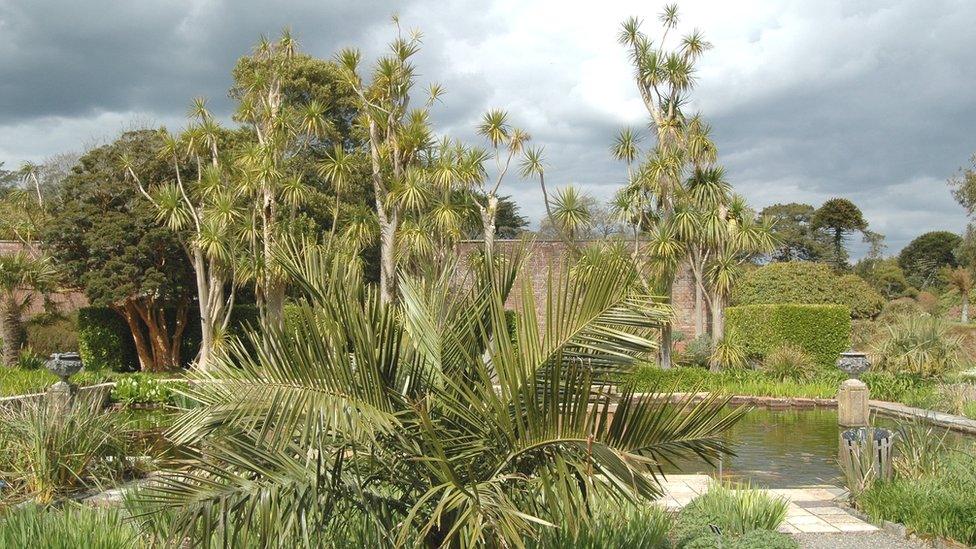Logan Botanic Garden bounces back after winter flooding
- Published

The gardens in southern Scotland enjoy an "almost subtropical climate"
Gardens in south west Scotland which are home to some of the world's rarest plants are recovering after serious flooding over the winter.
Logan Botanic Garden at Port Logan near Stranraer was badly hit in February as water poured across plant beds.
Curator Richard Baines described the situation at the time as "very concerning".
However, the gardens have been able to reopen without significant impact on the many rare species they host.
Flooding in the winter led to concern about the fate of plants at the site
The garden is home to 120 species that are threatened with extinction out of about 2,500 species in total.
It usually enjoys an "almost subtropical climate" in the south-west tip of Scotland and is renowned for its collection of plants not normally seen growing outside so far north.

They were put at risk when the heavens opened on 4 February and it recorded some of the highest rainfall of any part of the UK.
As the ground struggled to cope, by mid-morning a pond had overflowed and created a new water course heading over borders and paths.
The walled garden was one of the worst affected areas
Evidence of the damage done to the area has all but gone
"Initially, we were faced with a scene of devastation," Mr Baines said.
"Over the next fortnight the flooded area finally dried out and the scars of what had occurred were clearly visible.
"Deep craters had been gouged out in woodland paths, plant roots were exposed where the soil had been washed away and a layer of silt deposits covered the path in the walled garden."
It provoked a major repairs operation over the following weeks to prepare for the return of visitors.
The gardens near Port Logan have reopened to visitors
At the same time, the gardeners began counting the cost on what Mr Baines calls the "core reason" for Logan's existence as a regional garden of the Royal Botanic Garden Edinburgh - caring for species threatened in the wild.
"The flooding could have resulted in untold damage to the living collection," he said.
"A few sub-tropical gingers, including Hedychium yunnanense from North Vietnam could not handle the excess moisture and were unfortunate casualties.
"This was really disappointing for our ex-situ conservation programme and clearly demonstrates that plants in cultivation and in the wild are both vulnerable to the extremities of climate change."
A major repairs operation has been carried out at the site
By late April, the garden was back to its best with any damage hard to see and borders bursting with early flowering rhododendrons, camellias and exotic palms.
However, Mr Baines said the experience at Logan this winter was a cautionary one for all gardens and underlined the impact of climate change.
Experts say climate change is affecting the way all gardeners work
"As gardeners, we need to reduce the amount of paved areas that we have around our homes and businesses and increase the areas covered with soil to enable the rainfall to be absorbed and drain away naturally," he said.
"A lot of small actions can make a big difference.
"We also need to think about considering parts of the garden which at times may be naturally wetter collecting rainfall and selecting plant species that will tolerate the wetter conditions."
Logan is home to many plants rarely seen growing outside so far north
Borders at the garden have recovered well from the winter floods
Records at all four of the Royal Botanic Garden Edinburgh's gardens - at Logan, Edinburgh, Benmore in Argyll and Dawyck in the Borders - show the average temperature is rising along with rainfall intensity.
Last year there were only two frosts recorded all winter at Logan while Benmore also saw its wettest day ever on 4 February.
The changes have prompted the trial of a rain garden in Edinburgh to look at plants coping best with the new weather conditions.
Ultimately, said Mr Baines, the bottom line for everyone will be ensuring they "work with nature - not against it".
Trials are under way to see what plants cope best with changing weather conditions
All images are copyrighted.